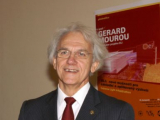Abstrakt: Hexa-peri-hexabenzocoronene (HBC) core tethered with three diacetylene (DA)-containing side-chains was designed and their self-assembling behavior in solvent and on substrate was investigated. The polymerizable HBC derivatives are noted as HBC-1,3,5-Ph-DA-Cn, where 1,3,5 refers to the position of DA chain and n is the spacer length of alkyl chain. It is confirmed that the nanostructure of HBC-1,3,5-Ph-DA-Cn can be polymerized in (i) solution and (ii) film by UV-irradiation or thermal treatment. HBC-1,3,5-Ph-DA-C12 exhibits a stable hexagonal columnar phase at 47°C which was used to...

